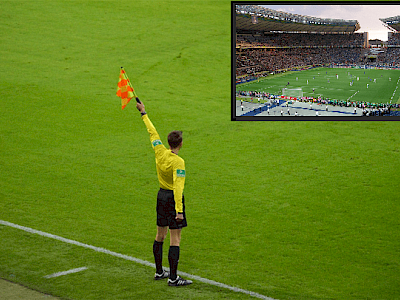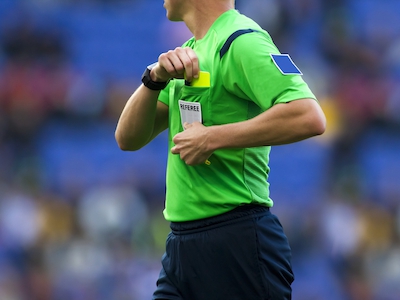Everything you need to know about VAR (Video Assistant Referee)
The VAR in football; everybody is acquainted with it by now. Video referees give advice to the head referee on the pitch from a separate room which contains multiple screens. The VAR is consulted in doubtful situations. That way, the course of the match becomes fairer. The VAR is a Dutch invention that was developed in 2010. You’ll read everything about what VAR is, how it works and what the latest developments are in this article.
What is VAR?
VAR is short for Video Assistant Referee. The referee on the field is usually assisted by three video referees. This team of (former) referees can either confirm or deny decisions rapidly and accurately made by the referee on the field through camera technology. The VAR room is also referred to as the operation room of football (or VOR: Video Operation Room). The VAR is both liked and disliked. It makes football fairer, but the game is usually slowed down in most VAR situations.
The Video Asisstant Referee is used in four situations: goals (and fouls preceding them) red cards, penalties and the misuse of yellow cards. The VAR can both reverse decisions taken by the referee and advise the referee to take a (different) decision.
The process works as follows: the VAR-team lets the referee know through a headset whether he has missed something that he needs to see or the head referee can ask the VAR for help. If the case is clear, the decision of VAR is instantly justified. In doubtful cases, the head referee walks to a screen at the side of the pitch to assess the situation himself on screen.
A list of VAR rules
We already hinted at it a little, but the VAR adheres to a three-step plan. The rules are as follows:
- An incident occurs: the referee informs the VAR or the VAR informs the referee to review the situation.
- Assessment and advice from VAR: the head referee is kept informated via headset of what can be seen on the screens.
- The decision can be made straight away when the situation is clear. The head referee can also choose to review the situation himself on a screen at the side of the pitch.
Examples of VAR decisions
We’ll explain a few typical VAR decisions to create a visual image of how the VAR works. You will get to see a penalty moment, a red card moment as well as an offside moment.
Harry Kane’s toe
In the following video you’ll see how Tottenham striker Harry Kane was declared standing offside. He then chips the ball over the goalkeeper straight into the goal. If VAR didn’t exist, the referee would have to guess whether this was offside or not. It appeared that only Harry Kane’s toe was offside after consulting with the VAR. The goal was justifiably rejected after the VAR intervened in the game.
A look inside the VOR at a penalty situation
The following snippet comes from 2020 when Fortuna Sittard played against Feyenoord. You can see the ball rolling into Feyenoord's penalty area. A Fortuna player kicks the ball, while Feyenoord's goalkeeper Justin Bijlow tries to punch the ball away. Instead of the ball, he hits the opponent's head. Referee Bas Nijhuis misses this and is called back by the VAR. In the video, you can see the entire VAR process, including Dutch communication. You can put on subtitles by clicking on the second to left icon at the right corner of the screen.
Red card for St. Juste thanks to VAR
In the fourth minute of the most classic match of Dutch football, the match between Ajax and Feyenoord, things go completely haywire for the club from Rotterdam. Defender Jeremy St. Juste is way too late and hits Ajax-back Tagliafico with a straight leg on both legs. The referee initially gives him a yellow card, but the VAR advises him to review the situation again because they think he should get a red card. Referee Kuips walks over to the screen and sees it at once: a red card.
Semi-automatic offside detection
The VAR is a new invention, and it keeps on developing. One of the most controversial developments is the semi-automatic offside detection. The technology makes it possible to detect an offside situation very accurately and within mere seconds.
Ten to 12 cameras in the stadium keep track of 29 data points of all players. Every second of each player is recorded in this system. When this semi-automatic VAR detects offside, an alarm immediately sounds and an animation is shown. During the World Cup in Qatar, this technology will be used on a large scale for the first time.
During the first couple of minutes of the World Cup’s opening match, the usefulness of the semi-automatic offside detection immediately became clear. The system acknowledged an offside situation, that was unclear to many viewers, perfectly. Would you like to know why that goal was offside? You can read it in our blog about the offside situation of Ecuador against Qatar during the World Cup.
The future of VAR
New VAR implementations such as the semi-automatic offside detection, can be put to use quite rapidly during big tournaments, such as the World Cup or the Champions League. Stadiums are built for it – or are being built for it – and there’s enough money available to facilitate the system. This is not yet the case with many national competitions. In short: the VAR will become quicker and more accurate in the coming years, but it will mainly be used during big football tournaments.
Last year, the VAR wasn’t used in small competitions and not even during the Conference League. Simply because not all clubs could afford the system. Before we get too optimistic on the VAR future, we first have to wait for the implementation of 'regular' VAR in more leagues.







